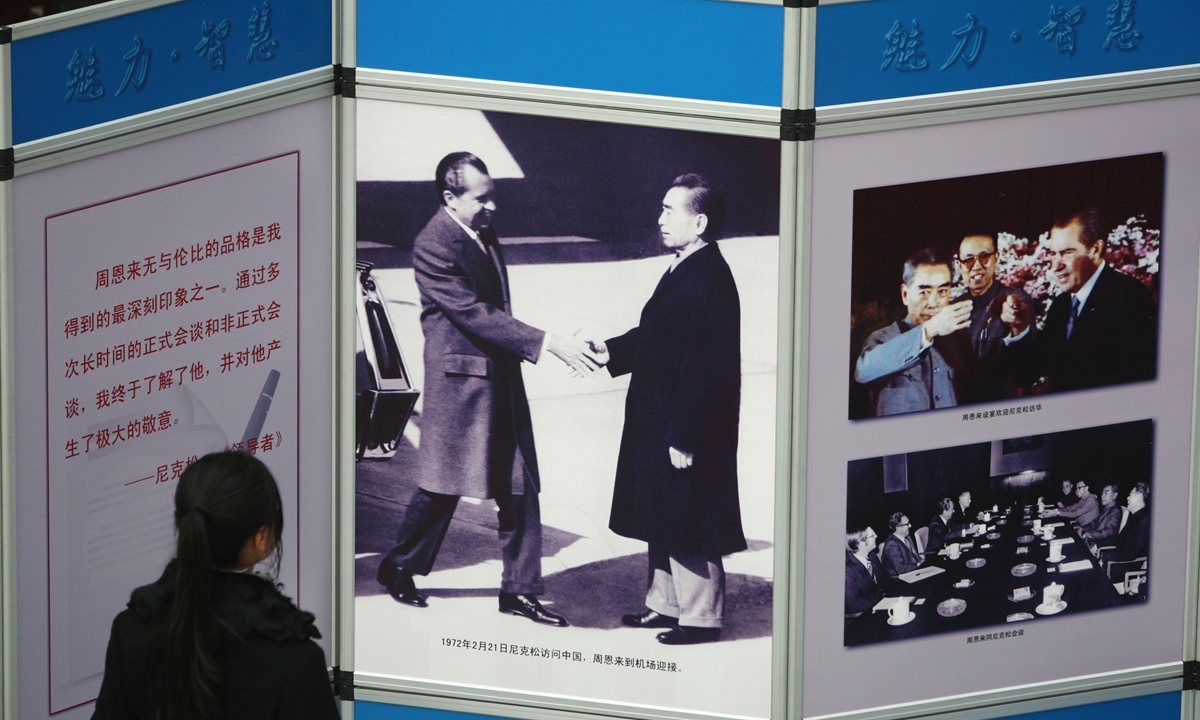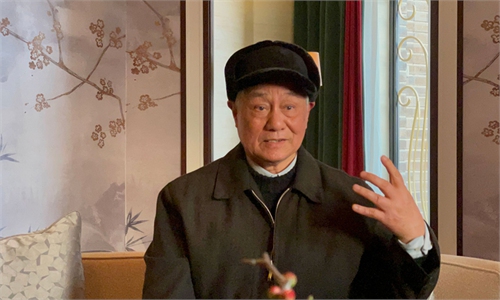'Guardrail' of China-US relations can be obtained from Shanghai Communiqué: Global Times editorial

An exhibition on US President Richard Nixon's visit to China Photo: cnsphoto
Fifty years ago, on February 28, 1972, China and the US issued the Shanghai Communiqué, ending the 22-year isolation between the two countries and laying the political foundation for the establishment of diplomatic relations between China and the US. From a broader perspective, the Shanghai Communiqué also foreshadowed the global multipolarization pattern that followed. Its appearance back then was like a rainbow across the iron curtain of the Cold War.
Today, when people evaluate the Shanghai Communiqué, they are still impressed by its wisdom of seeking common ground while reserving differences. The Shanghai Communiqué creatively laid out the divergences between China and the US in a frank and candid manner in the first place, and then elaborated on the consensus the two sides had reached. This demonstrates the willingness of the two sides to recognize differences and seek cooperation, and on this basis, to promote the development of bilateral relations; and thus creating a new pattern for countries with different political systems, cultural traditions and development stages to deal with each other. This became a pioneering practice in the history of international relations.
Since the publication of the Shanghai Communiqué five decades ago, the bilateral trade volume between China and the US has risen from around $90 million to more than $750 billion; the number of people-to-people exchanges between the two countries has increased from several thousand to more than 5 million per year before the COVID-19 pandemic; over 70,000 American companies have have invested in China; and the number of Chinese students studying in colleges and universities in the US exceeded 300,000. For the people of the two countries who have enjoyed tangible benefits, the Shanghai Communiqué is undoubtedly a big success. And for the vast majority of countries across the world which hope for peace and development, the Shanghai Communiqué is also undoubtedly a success.
History has repeatedly proved that as long as they adhere to mutual respect, seek common ground while reserving their differences, and cooperate for win-win results, China and the US would achieve peaceful coexistence and expand common interests. On the contrary, whenever the US deviates from the spirit of the Shanghai Communiqué, and points accusing fingers at China as if it were a proselytizer, threatening and interfering at every turn, China-US relations will experience twists and turns.
It should be noted that the root cause of the severe and complex challenges facing China-US relations today is that the US is constantly seeking changes and even cracking down over China. In the Shanghai Communiqué, the US explicitly admitted that "Taiwan is a part of China." But in recent years, the US has continuously made moves to challenge the bottom line of the one-China principle. In the Shanghai Communiqué, China and the US expressed their common wishes to reduce the danger of international military conflict. But in recent years, the US has been keen to engage in hegemonic military blocs in the Asia-Pacific and even the Indo-Pacific region. In the Shanghai Communiqué, China and the US agreed to facilitate the further development of people-to-people contacts and exchanges as well as bilateral trade between the two sides. Yet in recent years, the fields of economy, science and technology, and people-to-people exchanges have become the hardest hit areas in which the US has engaged in confrontation and "decoupling."
However, no matter how obsessed some so-called US strategists are with "great power competition," the successive crises at home and abroad have made Washington reluctantly realize that the US cannot choose between global challenges and "great power competition." Instead, it must deal with multiple choices simultaneously. China has always been a crucial force, both in addressing global challenges including climate change, and in maintaining a peaceful and stable international order. That is why Washington embraces the so-called three Cs of "competition, cooperation and confrontation" in its diplomacy with China, using "competition" to create a discourse trap, taking "cooperation" as an expedient and regarding "confrontation" as the ultimate goal..
Thus one sees a twisted US. On the one hand, it treats China as its main strategic competitor and even imaginary enemy for all-round containment. On the other hand, it says it pursues no new cold war, seeks no change to China's system, opposes the "Taiwan independence" and has no intention of confrontation with China. How can such inconsistency in words and deeds win the trust of China and the international community? The US should know that every time it goes back on its words, it is a loss of and squanders the country's credibility.
Previously, Washington coined the term "guardrails" out of the need to protect US interests in "great power competition." It is true that China and the US need "guardrails," but it will never be a "guardrail" unilaterally defined by the US for its own selfish interests. Instead, it should be a "guardrail" set up by both sides in order to achieve peaceful coexistence. If we carefully reread the Shanghai Communiqué, we believe that the elites in Washington can find the right way to install "guardrails" for China and the US. In particular, it is worthwhile for the US side to seriously consider and treat "mutual respect, peaceful coexistence and win-win cooperation," the three principles put forward by China in developing China-US relations in the new era. This reflects the inheritance and development of the spirit of the Shanghai Communiqué.
We have noted that among the elements of the US position in the Shanghai Communiqué, there is the statement that "no country should claim infallibility and each country should be prepared to re-examine its own attitudes for the common good." We are sure that the US meant something else at the time, but this is a particularly appropriate phrase to say to the US itself 50 years later. Referring to the Shanghai Communiqué, We hope that the US will revisit the original intention of the "ice-breaking journey," return to a rational and pragmatic understanding of China, and work with China to push China-US relations back to the right track of sound and stable development.



